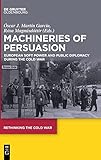Machineries of Persuasion : European Soft Power and Public Diplomacy during the Cold War / ed. by Óscar J. Martín García, Rósa Magnúsdóttir.
Material type: TextSeries: Rethinking the Cold War ; 3Publisher: München ; Wien : De Gruyter Oldenbourg, [2019]Copyright date: ©2019Description: 1 online resource (VI, 215 p.)Content type:
TextSeries: Rethinking the Cold War ; 3Publisher: München ; Wien : De Gruyter Oldenbourg, [2019]Copyright date: ©2019Description: 1 online resource (VI, 215 p.)Content type: - 9783110557923
- 9783110558098
- 9783110560510
- 327.409044 23
- D1058 .M33 2019
- online - DeGruyter
- Issued also in print.
| Item type | Current library | Call number | URL | Status | Notes | Barcode | |
|---|---|---|---|---|---|---|---|
 eBook
eBook
|
Biblioteca "Angelicum" Pont. Univ. S.Tommaso d'Aquino Nuvola online | online - DeGruyter (Browse shelf(Opens below)) | Online access | Not for loan (Accesso limitato) | Accesso per gli utenti autorizzati / Access for authorized users | (dgr)9783110560510 |
Frontmatter -- Table of Contents -- Machineries of Persuasion: European Soft Power and Public Diplomacy during the Cold War -- A “Many-Coloured Prism”: Exhibiting Polish National Identities in Cold War Britain -- Selling a Dictatorship on the Stage: “Festivales de España” as a Tool of Spanish Public Diplomacy during the 1960s and 1970s -- Playing to Win: The Moscow Olympics and the Augmentation of Soviet Soft Power during the Brezhnev Era, 1975–1980 -- Resetting the Relevance of the Berlin Wall. German Public Diplomacies on the African Continent During the Cold War -- Youth Brigadiers at the Railway – Personal Perspectives on Tito’s Yugoslavia in the Making -- “Fighting for Peace is Everyone’s Job”: The Independent Peace Movement in the USSR and the Soviet View of Public Diplomacy in the 1980s -- Next Stop Soviet: People to People Diplomacy during Glasnost -- The Eurovision Song Contest as Cultural Diplomacy during the Cold War: Transmitting Western Attractiveness -- “On a Scooter Journey to the Zone Border”. Danish Tourists in West Germany in the 1950s and 1960s -- Bibliography
restricted access online access with authorization star
http://purl.org/coar/access_right/c_16ec
Over the last two decades, public diplomacy has become a central area of research within Cold War studies. Yet, this field has been dominated by studies of the United States' soft power practices. However, the so-called 'cultural dimension' of the Cold war was a much more multifaceted phenomenon. Little attention has been paid to European actors' efforts to safeguard a wide range of strategic and political interests by seducing foreign publics. This book includes a series of works which examine the soft power techniques used by various European players to create a climate of public opinion overseas which favored their interests in the Cold war context. This is a relevant book for three reasons. First, it contains a wide variety of case studies, including Western and Eastern, democratic and authoritarian, and core and peripheral European countries. Second, it pays attention to little studied instruments of public diplomacy such as song contests, sport events, tourism and international solidarity campaigns. Third, it not only concentrates on public diplomacy programs deployed by governments, but also on the role played by some non-official actors in the cultural Cold War in Europe
Issued also in print.
Mode of access: Internet via World Wide Web.
In English.
Description based on online resource; title from PDF title page (publisher's Web site, viewed 28. Feb 2023)


